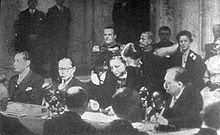Juliana of the Netherlands
The Queen's nearest relative was Prince Heinrich XXXII Reuss of Köstritz, whose close ties to Germany made him unpopular in the Netherlands.As the Dutch constitution specified that Princess Juliana should be ready to succeed to the throne by the age of eighteen, her education proceeded at a faster pace than that of most children.At the time, the House of Orange-Nassau was one of the most strictly religious royal families in the world, and it was very difficult to find a Protestant prince who suited their standards.Prince Bernhard, who had remained in London to assist his mother in law Queen Wilhelmina and the government with operating in exile, was able to visit his family in Canada and be there for Margriet's birth.She returned with Queen Wilhelmina by a military transport plane to the liberated part of the Netherlands on 2 May 1945, rushing to Breda to set up a temporary Dutch government.On 24 June 1945, she sailed on the RMS Queen Elizabeth from Gourock, Scotland, to the United States, listing her last permanent residence as London, England.However, before that happened, her mother, the Princess, clinging to any thread that offered some hope for a cure, came under the strong influence of Greet Hofmans, a faith healer with heterodox beliefs, who was considered by "her many detractors" to be a sham.Two days later, with the eyes of the world upon her, Juliana was sworn in and inaugurated as monarch during a joint session of the States General at a ceremony held in the Nieuwe Kerk in Amsterdam, becoming the 12th member of the House of Orange to rule the Netherlands.On 27 December 1949 at Dam Palace in Amsterdam, Queen Juliana signed the papers that recognised Indonesian sovereignty over the former Dutch colony.The near-blindness of her daughter Christina and the increasing influence of Hofmans, who had moved into a royal palace, severely affected the queen's marital relationship.Although the bicycle and the down-to-earth manners suggest a simple life style, the Dutch royal court of the 1950s and 1960s was still an opulent affair with chamberlains in magnificent uniforms, gilded state coaches, visits to towns in open carriages and lavish entertaining in the huge palaces.At the same time the queen began visiting the citizens of the nearby towns and, unannounced, would drop in on social institutions and schools like her mother before her insisting on seeing reality rather than a prepared show.Francis of Bavaria, a participant, reports in his memoirs the anecdote that the queens of Greece, the Netherlands and Italy went ashore in a harbor in the middle of a crowd of nephews and nieces, and a waiting journalist called out to them: "What is the purpose of this trip?Dressed in boots and an old coat, Queen Juliana waded through water and slopped through deep mud all over the devastated areas to bring desperate people food and clothing.Prince Bernhard planned to divorce his wife but decided against it when he, as he told an American journalist, "found out that the woman still loved him" [citation needed].Queen Juliana faced another crisis among her Protestant citizens in 1963, when her second daughter Irene secretly converted to Roman Catholicism and, without government approval, on 29 April 1964 married Prince Carlos Hugo of Bourbon, Duke of Parma, a claimant to the Spanish throne and also a leader in Spain's Carlist party.Another crisis developed as a result of the announcement in July 1965 of the engagement of Princess Beatrix, heir to the throne, to German diplomat Claus von Amsberg.Once again, Queen Juliana's weakness for the preternatural had landed her back in the headlines: she had invited to the palace a crackpot from California who numbered among his friends men from Mars, Venus and other solar-system suburbs.In the spring of 1975, a group of South Moluccans were caught conspiring to steal a heavy truck and ram the gates of Soestdijk Palace to kidnap the queen.Representing the Queen at the independence ceremony in the Surinamese capital, Paramaribo, were the heir presumptive Princess Beatrix, and her husband Prince Claus.Prime Minister Joop den Uyl ordered an inquiry into the affair, while Prince Bernhard refused to answer reporters' questions, stating: "I am above such things."As a reigning European monarch, she was given supernumerary membership of the British Order of the Garter as the 922nd inductee, with the rank of Stranger Lady Companion, in 1958.Queen Juliana was very attached to Monte Argentario, in Tuscany, a favorite place for the Dutch royal family for their summer holidays for more than 40 years.[15] Juliana died in her sleep on 20 March 2004 at the age of 94, at Soestdijk Palace in Baarn from complications of pneumonia, seventy years to the day after her grandmother, Queen Emma.















Princess Juliana International AirportQueen of the NetherlandsInaugurationWilhelminaBeatrixNoordeinde PalaceSoestdijk PalaceNieuwe Kerk, DelftPrince Bernhard of Lippe-BiesterfeldBeatrix of the NetherlandsPrincess IrenePrincess MargrietPrincess ChristinaOrange-NassauDuke Henry of Mecklenburg-SchwerinWilhelmina of the NetherlandsDutch Reformed ChurchabdicationQueen WilhelminaPrince Henry of Mecklenburg-SchwerinUniversity of LeidenMargrietChristinainvasion of the NetherlandsSecond World WardecolonizationDutch East IndiesSurinameThe HaguePrince Heinrich XXXII Reuss of KöstritzGermanyHet Loo PalaceApeldoornHuis ten BoschJan LigthartBaroness Elise BentinckBaroness Elisabeth van HardenbroekJonkvrouweMiek (Mary) de Jongesociologyjurisprudenceeconomicshistory of religionconstitutional lawNetherlands Antillesinternational affairsinternational lawEuropean lawbachelor's degreeSophia AntoniadisHouse of Orange-NassauProtestantUnited KingdomSweden1936 Winter OlympicsBavariaGermanLebrecht, Prince of Anhalt-Zeitz-Hoymprenuptial agreementAdolf HitlercitizenshipKing William IIIQueen Emmacivil ceremonyDuchess Woizlawa Feodora of Mecklenburg-SchwerinDuchess Thyra of Mecklenburg-SchwerinGrand Duchess Kira Kirillovna of RussiaPrincess Sophie of Saxe-Weimar-EisenachPrincess BeatrixRadio Oranjegovernment in exileOttawaCanadaStornowaysuburbRockcliffe ParkDutch government-in-exileLord Athloneroyal assenta special lawOttawa Civic Hospitalextraterritorialdual nationalityline of successionPeace TowercarillonLondonSt. Andrew's Presbyterian Church (Ottawa)Kees van EendenburgDeanlandRMS Queen ElizabethGourockScotlandUnited StatesEnglandCanadian Tulip FestivalAnnevilleHunger WinterDutch Red CrossMarijke ChristinarubellacataractsGreet Hofmansfaith healerheterodoxregentgolden jubileeIndonesiasworn in and inauguratedNieuwe KerkAmsterdamDam PalaceDutch colonyNetherlands-Indonesian UnionCaribbeanMevrouwQueen FredericaPaul of GreeceCruise of the KingsFrancis of Bavariaunion’sthe most destructive storm in more than five hundred yearsstorm surgesJuscelino Kubitschekconstitutional crisispacifist